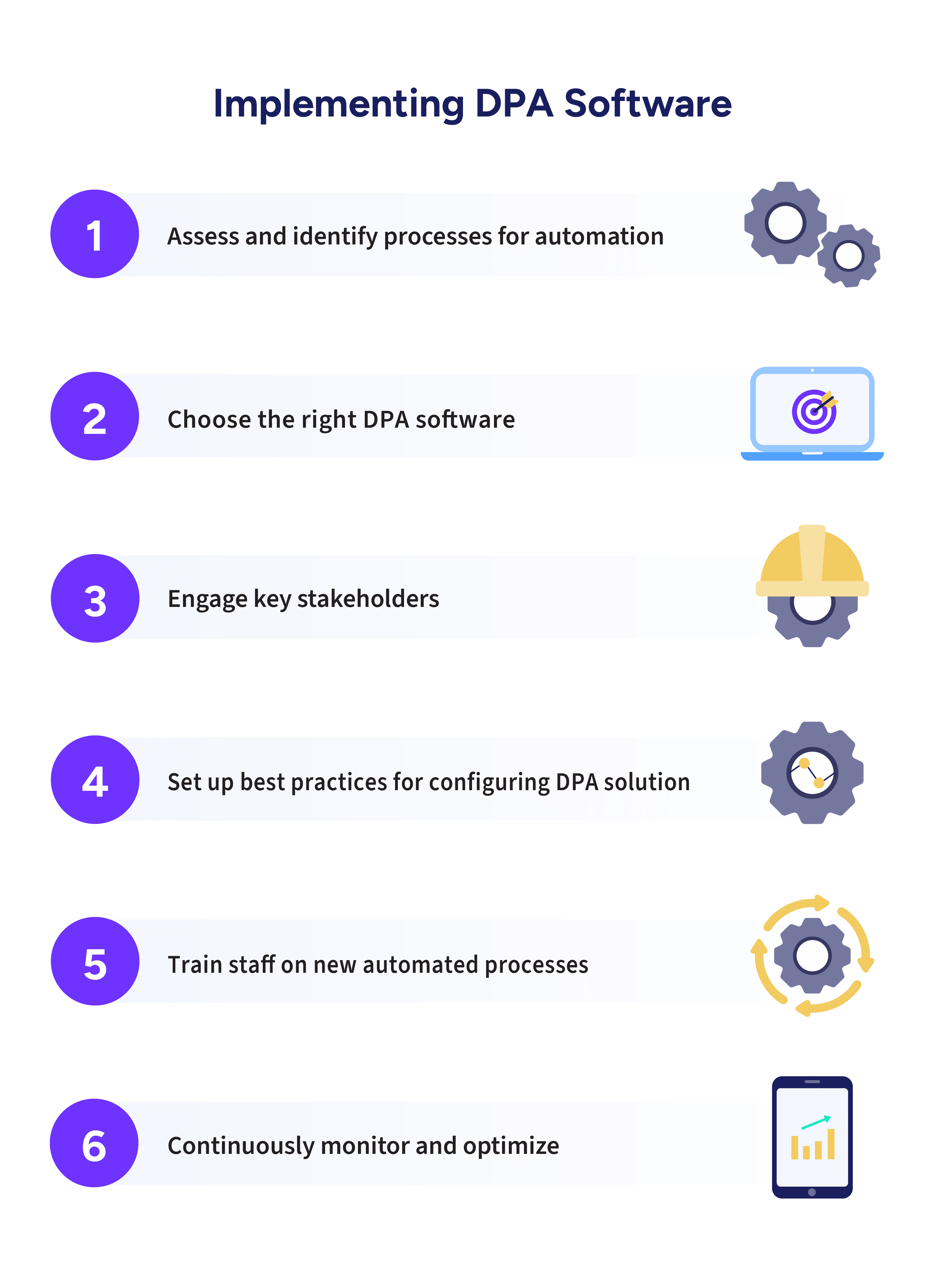Digital process automation (DPA) software
Overview of Digital Process Automation (DPA) software and its role in enhancing operational efficiency and productivity in modern enterprises.
Overview of Digital Process Automation (DPA) software and its role in enhancing operational efficiency and productivity in modern enterprises.

Digital process automation (DPA) software automates complex business workflows, optimizing processes across departments and systems to:
DPA software refers to tools that automate end-to-end business processes involving human interaction, multiple systems and complex workflows.
Unlike traditional automation tools, which focus on automating repetitive, individual tasks, DPA integrates various systems to automate entire processes across departments, allowing human input at different decision points.
Equipped with powerful features, DPA platforms allow businesses to manage, monitor and adapt their processes effectively. This includes:
Centralized workflow management enables organizations to oversee all processes from a single dashboard.
This feature helps businesses track progress, monitor tasks and ensure that every step in a workflow is rightly executed, making it easier to spot bottlenecks or inefficiencies.
The ability to seamlessly integrate with existing systems, such as customer relationship management (CRM), enterprise resource planning (ERP) or electronic document management system (EDMS) allows businesses to connect disparate tools and systems, streamlining data flow and enabling automated, cross-functional processes.
By removing silos between systems, organizations can improve communication and data sharing across departments.
DPA platforms offer detailed dashboards and reporting tools that allow organizations to track key performance indicators (KPIs), monitor process efficiency and identify areas for improvement.
These real-time analytics and insights enable data-driven decision-making and help businesses optimize their workflows on a continuous basis.
Designed to accommodate different types of processes, businesses can tailor workflows to meet their specific needs, adjusting rules, conditions and task sequences without heavy coding or IT involvement.
This flexibility enables quick adaption to changing requirements, ensuring businesses remain agile and responsive.
Intuitive, easy-to-use interfaces allow nontechnical users to create, manage and modify workflows with minimal training.
The simplicity of the interface promotes widespread adoption by reducing the learning curve and ensuring employees across the organization can leverage the platform’s capabilities.

"AI is now table stakes in the Capture & IDP market."
Discover how the capture and IDP industry is evolving with groundbreaking advancements in AI and generative technologies in this 2024 Infosource Global Vendor Matrix report. With highlights on top-performing vendors, key market trends and actionable insights, use the report to explore detailed vendor profiles and strategies.
DPA software leverages intelligent automation to transform business operations, helping organizations achieve:
The Horry County Auditor’s Office implemented Hyland’s RPA as part of a DPA strategy, automating the entry of 30,000 property tax returns without human intervention.
By integrating RPA with existing systems and leveraging conditional business rules, the county streamlined complex workflows, improved data accuracy and ensured compliance.
Read the case studyIt’s important to have a strategic approach when implementing DPA software. Follow these steps to ensure your platform delivers maximum value:

Prioritize processes that are repetitive, time-consuming, prone to errors and require coordination between multiple departments or systems.
Consider factors such as integration capabilities, scalability, ease of use and support for customization.
Engage key stakeholders across departments to gain buy-in and ensure that the software addresses the needs of all teams.
Set up clear guidelines for automation, such as defining process boundaries, establishing approval workflows and setting performance benchmarks.
Provide in-depth training to ensure that employees understand the functionality and fully leverage the benefits of the automation.
Regularly review the system’s analytics and reports to identify areas for improvement and ensure it continues to meet business needs.
Indications are that DPA software will play an even more critical role optimizing business operations in the future. Here are things to keep an eye on:
Technologies such as robotic process automation (RPA), Internet of Things (IoT) and blockchain integrating with DPA software are making processes more intelligent, responsive and secure. They allow businesses to automate complex, multistep workflows that span across various systems.
Additionally, the growing emphasis on hyperautomation is reshaping how organizations approach process automation. Businesses will be able to create intelligent, adaptable processes that can continuously optimize themselves based on real-time data and insights.
AI and ML algorithms enable DPA platforms to learn from historical data and make predictive decisions, creating dynamic and adaptable workflows.
The integration of AI and ML automate decision-making processes that were once dependent on human intervention, enabling businesses to predict outcomes, personalize customer interactions and detect patterns or anomalies in real-time.
Expect DPA software to become more user-friendly, with low-code or no-code platforms making automation accessible to a broader range of business users. Plus, advancements in AI will enable more autonomous workflows, reducing the need for manual oversight.
DPA solutions will increasingly support multi-cloud environments and decentralized operations as organizations seek to streamline more complex and interconnected processes.
Cloud-based DPA offers increased scalability for organizations to quickly adjust their automation infrastructure as business needs change. Additionally, through centralized access, teams from different locations will be able to work together seamlessly, improving collaboration.
Cloud-based DPA also facilitates faster deployment with the time and cost involved in setting up systems significantly reducing. Lastly, security features in cloud environments will keep improving, ensuring that automated workflows remain secure and compliant with industry regulations.
Capita, a prominent business process outsourcing provider, collaborated with Hyland to streamline its complex order change process for a major German utility provider.
By standardizing product change cards and implementing robotic process automation (RPA) combined with intelligent data capture, Capita automated the tedious tasks of scanning, data entry and validation.
Read the case studyDPA automates entire workflows across systems, while traditional automation tools focus on isolated, repetitive tasks.
Look for workflow automation, integration capabilities, real-time analytics, customizable workflows and user-friendly interfaces.
DPA improves efficiency by streamlining processes, reducing manual tasks and speeding up workflows.
DPA ensures adherence to regulations by automating compliance-related tasks and maintaining accurate audit trails.
Yes, DPA software is scalable and can be customized to suit the needs of both small and large businesses.
Yes, DPA platforms are designed to integrate with both modern and legacy systems.

The use of AI in process automation will disrupt workplaces — just make sure your organization is leading.

From invoice processing automation to streamlining data entry, BPA allows for faster, more accurate outputs enterprise-wide.

Discover how AI helps organizations unlock efficiency, enhance customer experiences, empower a workforce and drive innovation.

The combination of RPA and AI in intelligent process automation transforms the way organizations operate by enhancing efficiency, improving decision-making and streamlining processes.